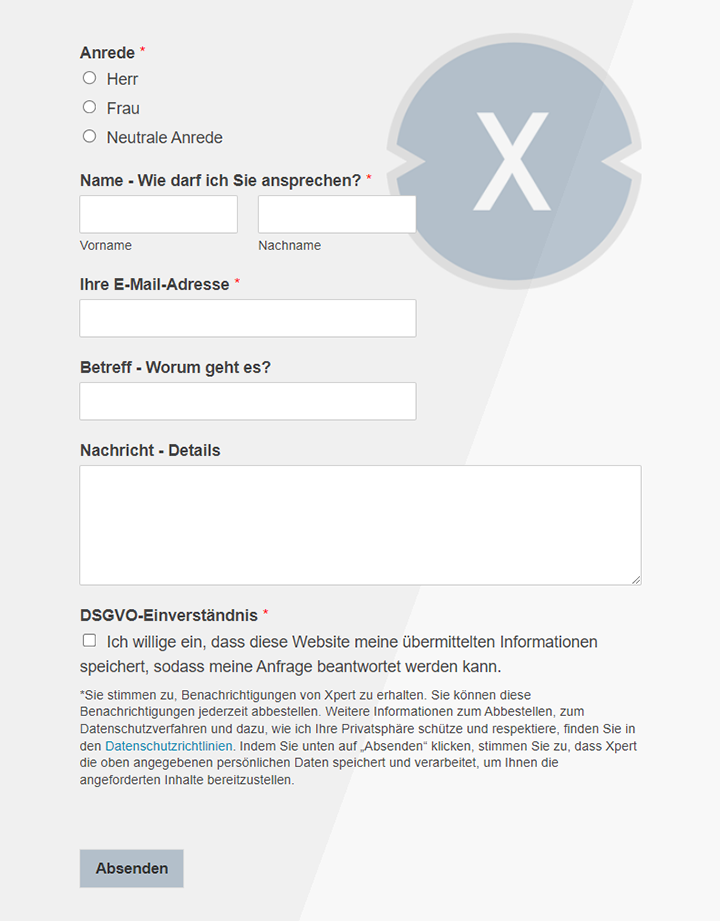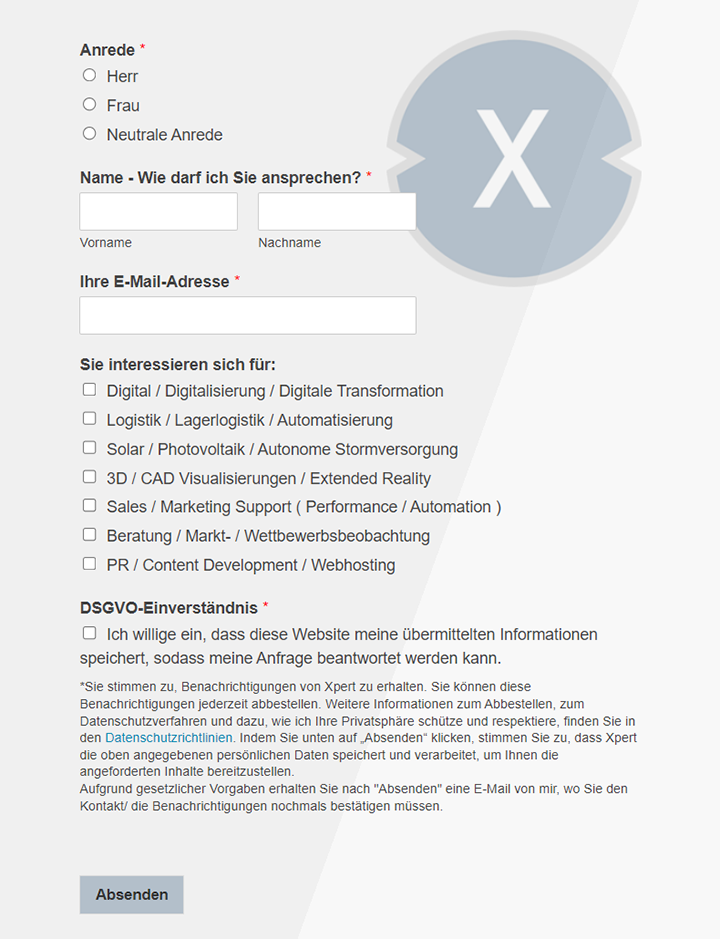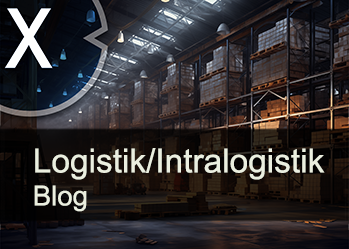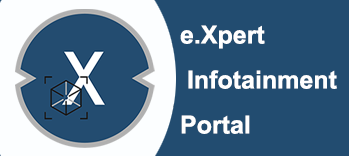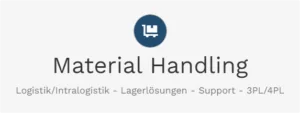Strategic realignment of the supply chains and logistics: A requirement of the hour - at short notice, in the medium term and long -term
Xpert pre-release
Language selection 📢
Published on: April 9, 2025 / update from: April 9, 2025 - Author: Konrad Wolfenstein

Strategic realignment of the supply chains and logistics: A requirement of the hour - at short notice, in the medium term and long -term - Image: Xpert.digital
The times of cost optimization are over: new priorities in logistics
German economy under pressure: strategic answers to global challenges
The German economy, known for its export strength and global networking, faces a turning point. The times when supply chains were primarily viewed from the point of view of cost optimization are over. A number of factors - geopolitical tensions, unpredictable trade conflicts, the growing threat from cheap providers and the need to catch up technologically - German companies force a fundamental strategic realignment of their supply chains and logistics.
Suitable for:
A multi -layered problem area
The challenges are complex and diverse. They can be divided into the following core areas:
Geopolitical instability and trade conflicts
The world has become more restless. Trade wars, protectionist measures and political tensions between great powers such as the USA and China have a direct impact on German companies that rely on smooth international trade currents.
Market risks and competitive pressure
The shortage of goods, market distortions and the increasing competition by low -cost providers, especially from China, put the margins of German companies under pressure and threaten their market position.
Technological change
Digitization progresses unstoppably and changes the rules of the game in the logistics and supply chain world. Companies that are unable to adapt new technologies run the risk of losing connection.
Sustainability requirements
The call for more environmentally friendly and more socially acceptable supply chains is louder. Companies that close these requirements risk reputation damage and competitive disadvantages.
The need for a strategic realignment
In order to be able to survive in this complex and dynamic environment, German companies must fundamentally rethink their logistics and supply chain strategies. It is no longer enough to react to disorders at short notice. Rather, a holistic approach is required that takes the following aspects into account:
Risk management
Have the identification, evaluation and minimization of risks along the entire supply chain.
Flexibility and resilience
Suppliers must be more resistant to disorders and in a position to quickly adapt to changed conditions.
Technology use
Digitization offers enormous opportunities for increasing efficiency, improving transparency and automation of processes.
sustainability
Environmental and social aspects must be integrated into the supply chain strategy.
Suitable for:
- Resilience through diversification: Strategic realignment of global supply chains in the geopolitical area of tension
The changing environment: challenges for German supply chains
Commercial conflicts and their consequences
The trade voltages between the USA and China, but also other global conflicts, have direct and indirect effects on German companies. The US customs policy, which, among other things, provides for tariffs from the EU and China, increases imports and exports and affects the competitiveness of German companies.
The Federal Association of Major and Foreign Trade (BGA) warns of the consequences of these conflicts, especially of disturbed supply chains, shortages of goods and market distortions. Customs act like taxes on cross -border trade. They increase the costs of imports, distort price structures and can heat inflation. Even the announcement of tariffs can generate considerable market volatility and uncertainty, which makes investment decisions difficult.
However, the conflicts go beyond tariffs and manifest themselves in a systemic rivalry, for example between the USA and China, which also includes export controls for strategic goods such as semiconductors or rare earths and destabilizes key industries.
Perhaps the most serious impact of these trade conflicts is not only the direct increase in costs through tariffs, but the omnipresent uncertainty that they generate. This uncertainty often forces companies into reactive, short -term measures, such as pre -ordering goods from expected tariff increases. However, such tactics are associated with considerable risks, including high capital binding, potential storage costs and the risk that stocks are observed. In addition, they can often only be implemented limited, for example due to production capacity limits in suppliers. This uncertainty complicates strategic long -term planning and leads to the management of this uncertainty itself becoming a significant operational and financial burden. This requires fundamental change in planning: away from pure reaction to events that have occurred to the development of proactive plans for various plausible future scenarios.
In addition, the trade conflicts accelerate a fundamental paradigm shift in the supply chain strategy. The previously dominating model, which primarily aimed at cost minimization through global relocation, increasingly gives way to an approach that focuses on active risk management and resilience. Companies recognize the need to make supply chains more resistant, even if this is associated with higher costs. Political uncertainty, such as causes from US trade policy, itself becomes a risk factor that forces a reorganization of global supply chains, which no longer only follows efficiency considerations. Resilience thus becomes a primary strategic goal in addition to cost efficiency, which changes the way in which supply chain power is evaluated and controlled.
Shortage of goods and market distortions
The effects of trade conflicts and supply chain disorders affect German export sectors differently, with some being particularly exposed. The automotive industry, including its suppliers, is repeatedly mentioned as highly susceptible to US tariffs and for disorders in Chinese supply chains. The chemical industry, mechanical engineering, the electronics industry and the pharmaceutical industry are also significantly affected due to their strong international integration, especially with the USA and China.
There can be a shortage of goods from various mechanisms: direct interruptions of delivery routes, such as those observed during the COVID-19-lockdowns in China, cost increases that make certain imports unprofitable, or also by retaliation that restrict the availability of essential components. The dependence on China in specific critical advance performance, such as certain raw materials or pharmaceutical agents (e.g. antibiotics, vitamin B), exacerbates this risk.
Market distortions are another direct episode. Customs and trade conflicts change established price structures, create competitive disadvantages for affected products and can lead to shifts of market shares. They also promote trades in trade, in which companies are forced to switch to alternative, potentially more expensive or less efficient procurement sources or transport routes. An additional risk arises from so-called “managed trade” agreements, such as the phase 1 agreement between the USA and China, which can lead to trading currents specifically indulged by third countries such as the EU.
The combination of tariffs and supply chain disorders contributes significantly to cost inflation. Higher import prices, increased logistics costs due to route changes or capacity bottlenecks as well as potentially higher domestic production costs for reshoring measures are reflected. This burdens both consumer prices and the margins of companies.
Linking direct cost increases due to tariffs and indirect effects such as uncertainty and potential bottlenecks creates increasing negative pressure on the profitability of German companies. This pressure of margins forces difficult considerations: absorb costs and reduce profits, pass on costs to customers and risk decays, or make costly restructuring of the supply chain. The expectation of a permanent strain on the margins expressed in company surveys indicates that this is not a temporary phenomenon, but a structural shift. The financial burden goes beyond the immediate customs costs and includes the running costs for the management of a more risky environment (e.g. higher stocks, costs for diversification). This requires fundamental adjustments to the business models that go beyond a simple transfer of costs.
The challenge of cheap competition
In addition to the direct effects of trade conflicts, the BGA warns of growing cheap competition, which is fueled by overproduction in China. This trend manifests itself, especially in e-commerce, through the aggressive advance of Chinese online platforms such as Temu and Shein, which gain rapidly market shares in Europe and the USA.
Your business model is based on several columns: a direct consumer-to-manufacturer (C2M) approach that deals with the intermediate dealer; a highly developed, data -driven analysis of consumer trends using algorithms; Extremely agile supply chains based on the principle of “small order, quick reorder”, which enable a quick adaptation to demand; massive marketing spending on social media and search engines; as well as psychological price and sales tactics on their platforms (gamification, time pressure).
At the same time, there are concerns about unfair competitive practices. This includes allegations of the bypass of EU regulations, in particular when paying customs fees through systematic underd Clarification of goods below the 150 euro limit, as well as possible violations of consumer protection standards. The EU Commission has already launched official investigations against platforms such as Temu and Shein.
This massive price pressure is a significant challenge for traditional European retailers who are often unable to compete at this price level without suffering without losses. This also potentially affects the logistics service providers who serve these dealers. The cause of this aggressive export pressure could be in overcapacity in Chinese production, possibly increased by state subsidies or a relocation of the focus on internal economic developments.
However, the success of platforms such as Temu and Shein is not based solely on low prices. It is also their highly agile, data -controlled and directly on the end customer supply chain models that represent a competitive advantage. These models challenge traditional retail and logistics structures in terms of speed, responsiveness and customer interaction. For German companies, this means that a pure reaction to the price points is not sufficient. It is important to address both the aspects of fair competition as well as to understand the underlying, innovative operational models and, if necessary, adapt elements to secure their own competitiveness.
🎯🎯🎯 Benefit from Xpert.Digital's extensive, fivefold expertise in a comprehensive service package | R&D, XR, PR & SEM

AI & XR 3D Rendering Machine: Fivefold expertise from Xpert.Digital in a comprehensive service package, R&D XR, PR & SEM - Image: Xpert.Digital
Xpert.Digital has in-depth knowledge of various industries. This allows us to develop tailor-made strategies that are tailored precisely to the requirements and challenges of your specific market segment. By continually analyzing market trends and following industry developments, we can act with foresight and offer innovative solutions. Through the combination of experience and knowledge, we generate added value and give our customers a decisive competitive advantage.
More about it here:
German logistics in change: strategies for uncertain times
Strategic imperative for German logistics and supply chains
In view of the complex and uncertain environment, German companies have to rethink and adapt their logistics and supply chain strategies. This requires a staggered approach to short, medium and long-term time horizons.
Short -term tactical reactions
In the immediate response to trade conflicts, tariffs or sudden supply chain interruptions, tactical measures are in the foreground to limit the damage and maintain the ability to operate.
Inventory management
A common reaction is the adaptation of the inventory. Pre -order or increase in inventory for critical components or ready -made goods before the entry of expected tariffs or bottlenecks that are expected can secure lower prices at short notice. However, this strategy carries considerable risks: it requires high liquidity, binds capital and increases the risk of excesses, outdoor and additional storage costs. In addition, it is limited by production capacities on the supplier and buyer side and is only a temporary solution. An alternative or supplement are differentiated safety stock strategies based on a detailed risk analysis instead of flat rate.
Transport & logistics
The continuous review and adaptation of transport routes is essential. Companies should analyze existing routes towards cost efficiency and potential bottlenecks and identify and evaluate alternative routes (e.g. other seaports, air freight, rail traffic - taking geopolitical risks such as the Trans -Siric Route) in order to avoid traffic jams or customs loads. However, possible capacity bottlenecks on alternative routes, for example in the case of container freight room or through harbor strikes, must be taken into account. At the same time, the proactive securing of existing transport capacities for logistics partners, especially on critical routes, is important. The selection of service providers that offer continuous data connectivity to tracking shipping is becoming more important.
Supplier collaboration
Intensified communication and cooperation with key suppliers enables early warning signals for potential disorders and developing emergency plans together.
Transparency & monitoring
The implementation or improvement of supply chain visibility tools is crucial. They enable real -time monitoring of shipment volumes, transport capacities and potential delays. Proactive adjustments can be made by using this data before disorders affect the inventory.
Crisis reaction teams
The establishment of cross -functional reaction teams can help to observe political and economic developments, to quickly analyze risks and to make tactical decisions promptly.
Contract examination
Legal experts should check existing supplier and customer contracts in order to clarify the responsibilities for additional costs, for example through newly introduced tariffs.
The effectiveness of these short-term measures depends largely on high real-time transparency and advanced data analysis skills. Blinds react, such as an undifferentiated increase in inventory, is not only risky, but often also inefficient. The ability to monitor and analyze shipments, capacities and potential bottlenecks in real time enables more targeted and efficient tactical adjustments - be it selective route changes or dynamic inventory adjustments. Without this transparency, measures remain purely reactive and potentially counterproductive.
Suitable for:
- City – country – logistics and future-proof logistics strategies: The integration of nearshoring and buffer warehouses
Medium -term adaptation strategies
In addition to short -term measures, the structural changes in global trade require medium -term adjustments to increase flexibility and reduce critical dependencies.
Diversification of the supplier base
A central strategy is the active expansion of the supplier network across various geographical regions. The aim is to reduce the dependence on individual countries, especially China. This includes systematic identification, qualification and integration of new suppliers. Support networks such as the foreign trade chambers (AHKS) can provide valuable help here.
Diversification of the production locations
In parallel to supplier -versification, companies should check the relocation or the establishment of additional production capacities in various regions. Different approaches can be made here:
- Nearshoring: relocation of production in geographical proximity to the home market (e.g. Eastern Europe for Germany). This can offer shorter delivery times and lower transport risks, often at moderate costs.
- Friendshoring: Relocation of procurement and production to countries that are considered geopolitical allies and share similar values. Here the stability and reliability of the relationships are in the foreground, potentially even at higher costs.
- Regionalization: Construction of regional supply chains hubs that serve local markets. This strategy promotes resilience compared to global shocks and can improve reaction ability to regional market requirements.
- Onshoring/Reshoring: Relocation of production to your own country (Germany). Offers maximum control, short delivery routes and strengthens the domestic economy, but is often associated with higher costs and challenges such as a shortage of skilled workers.
Suitable for:
Network -based supply chains
The transition from rigid, linear supply chains to more flexible, network -based structures is crucial. Such networks include multiple procurement options, alternative production locations and redundant logistics paths to have alternatives available if an element fails.
Trade agreement as a catalyst
Free trade agreements (FTAs) play a critical role in enabling diversification strategies by reducing tariffs and non -tariffs and facilitating access to new markets. Companies should support political efforts to conclude and ratify such agreements (e.g. with Mercosur, India, Indonesia, Thailand).
Customs optimization strategies
Medium-term customs planning includes the optimization of the goods classification, the use of specific customs procedures (e.g. “First Sale Rule” for US imports) or the structuring of transactions for minimizing tax burdens. The establishment of internal expertise in the area of customs and compliance is necessary.
Strategic partnerships
Cooperation with other companies can help bundle resources, share logistics costs or to invest in new supply chain infrastructures.
The decision between Nearshoring, Friendshoring and Reshoring is rarely a either-or question. Rather, companies are increasingly developing a portfolio approach for diversification, often referred to as “multi-localization”. Instead of moving all activities to one place, they build networks with different geographical focus. The optimal mix depends on product -specific requirements, market priorities, risk to risk and cost structures. This requires demanding skills in the field of network design and optimization, often supported by mathematical modeling.
Although diversification strategies such as nearshoring are widely discussed, their actual implementation encounters considerable hurdles. This includes high investment costs, the complexity of the relocation processes, a shortage of skilled workers in the target regions and the potentially falling attractiveness of domestic or nearby locations based on factors such as energy costs or bureaucracy. This explains the gap between the intention of many companies to regulate their supply chains, and the actual implementation, in which often short -term measures such as inventory increases were preferred. A successful medium -term adjustment therefore not only requires strategic will, but also the overcoming of these practical barriers, possibly through the targeted use of technology (e.g. automation to compensate for wage costs or a shortage of skilled workers) and the use of state support programs.
Long -term resilience and future viability
In order not only to make supply chains more resistant to current shocks, but also to make them sustainable in the long term, strategic investments in digitization, geographical realignment, sustainability and skills are required.
Digital transformation as the centerpiece
Digitization is not an optional add-on, but a fundamental component for resilient and efficient supply chains of the future.
End-to-end transparency: Investments in advanced digital platforms are essential in order to achieve comprehensive real-time transparency across the entire supply chain network, ideally into lower supplier levels. This transparency is the basis for proactive risk management and optimization.
- AI and predictive analysis: The use of artificial intelligence (AI) and Machine Learning enables precise demand forecasts, the early identification of potential disorders (based on various data sources such as news, weather, social media), the optimization of stocks and transport routes as well as automated decision -making (e.g. dynamic route planning, adaptation of Procurement sources). Long -term goal can be a “self -healing” supply chain that reacts autonomously to disorders.
- Automation: The implementation of automation technologies in warehousing (robotics), logistics and potentially also in production increases efficiency, reduces the dependence on manual work (which also counteracts the shortage of skilled workers) and improves process consistency.
- Digital twins: The use of digital twins enables modeling, simulating and testing various supply chain scenarios and the optimization of the network design under different conditions.
Near/reshoring as a long-term strategy
Geographical relocations should not only be regarded as medium -term risk minimization, but as part of long -term strategic positioning. In addition to increased resilience, advantages can also be greater proximity to the market, better quality control and a positive brand image. However, this often requires significant investments in modern manufacturing technologies (e.g. automation) and the qualification of the workforce.
Sustainability and circularity
The integration of sustainability aspects into the supply chain strategy is becoming increasingly important. This includes the reduction of CO2 footprint (e.g. by shorter transport routes in nearshoring or optimized logistics using AI), compliance with environmental regulations and the research of models from the circular economy (circular economy). Although ESG criteria are currently being prioritized by some of some customers than reliability, many companies recognize the potential of circularity to increase resilience (resource independence) and as an opportunity for Germany, despite challenges such as implementation costs and a lack of customer acceptance for higher prices.
Talent and competencies
The critical lack of specialists with digital and supply chain skills must be addressed. Long-term strategies require investments in the training and further education of the existing workforce as well as in the extraction of new talents with the required skills in IT, data analysis and modern production.
Agile and flexible operations
It is important to establish an organizational culture and operational processes that promote agility, adaptability and continuous improvement in order to be able to exist in a permanently uncertain environment.
Long -term resilience is increasingly linked to digital ripeness and sustainability. Companies that invest in integrated digital skills (transparency, AI, automation) and sustainable practices (circular economy, emission reduction), build more adaptable, more efficient and ultimately more competitive supply chains for the future. These aspects are not isolated initiatives, but mutually reinforcing components of a sustainable strategy. Digital tools enable better resource management, optimized logistics and can facilitate circulatory models, while sustainability goals drive innovations into processes and network design, often enables digital technologies.
However, the transition to such resilients, digitized and sustainable supply chains requires considerable investments and profound organizational changes. Hurders such as high costs, the lack of specialists and the need for cultural adjustments are significant. The overcoming of these challenges requires strong commitment to corporate management, strategic partnerships and potentially the use of external support, be it by consulting companies or government support programs. The way to future viability is complex and resource -intensive.
Previous of the resilience
In order to implement the strategic imperative and make supply chains more resilient, technological innovations, supportive political framework and learning from successful examples play a crucial role.
Technology as a lever
Modern technologies offer transformative options for increasing efficiency, transparency, security and ultimately resilience in global supply chains.
Artificial Intelligence (AI)
- Applications: AI algorithms enable predictive analyzes for improved demand forecast and to identify risks before they occur. You optimize transport routes, inventory management and can automate processes through Robotic Process Automation (RPA). AI can also improve cooperation with suppliers and is a key element on the way to “self -healing” supply chains.
- Advantages: significant increases in efficiency and cost reductions (forecast errors can be reduced by up to 50%, inventory by up to 40%), improved decision -making as well as increased agility and resilience. KI also offers the potential to partially compensate for high wage costs in locations such as Germany.
- Challenges: High requirements for data quality and quantity, complexity of algorithms and integration, ethical questions and data security. However, companies rated the potential as great.
Suitable for:
- Autonomous mobile robots (AMR) and artificial intelligence (AI): cost reduction and efficiency boost in intralogistics
Internet of Things (IoT)
- Applications: IoT sensors enable real-time tracking and monitoring goods during transport (position, condition and temperature). They support automation in the warehouse (e.g. inventory using RFID/drones) and enable forward -looking maintenance of systems. IoT devices generate huge amounts of data that serve as an input for AI analyzes.
- Advantages: significantly improved transparency and visibility along the supply chain, better control over logistics processes, faster response to deviations and optimized utilization of resources. The high planned adoption rates indicate the perceived benefit.
- Challenges: Ensuring connectivity (5G as an important enabler), management of the end devices, data security and integration into existing IT systems.
Blockchain
- Applications: Blockchain technology creates safe, transparent and unchangeable records of transactions and goods movements across corporate boundaries. It improves the traceability of products (e.g. in the food industry), serves the authenticity test and facilitates compliance requirements. It can also increase the safety of delivery charging data.
- Advantages: increased trust between the partners, improved data integrity and security, increased transparency and traceability as well as potentially streamlined processes.
- Challenges: Questions of scalability, interoperability between different systems, standardization, energy consumption (depending on the consensus mechanism) and governance models. Blockchain is often used in combination with AI and IoT.
The full potential of these technologies only unfolds through their convergence and integration. IoT devices collect the data, analyzes AI and makes predictions or decisions, and blockchain ensures the safe and transparent documentation of the transactions. Together they form a robust technological foundation for highly grade resilient and efficient supply chains.
Although technologies such as AI, IoT and blockchain offer significant potential, their effective implementation requires a holistic approach. This must ensure the data integration across system boundaries, contain a redesign of the processes in order to exploit the technological possibilities and include the further training of the employees so that they can operate and manage the new systems. The mere introduction of island solutions will only bring limited advantages. Success depends on the creation of a coherent digital ecosystem, in which data flow seamlessly, processes are adapted and employees have the necessary skills. This requires strategic planning that goes beyond pure technology creation.
Political and regulatory framework
When adapting their supply chains, companies must also take into account the relevant political and regulatory framework at the national and European level. This frame not only sets limits, but also offers support options.
German supply chain assistant law (LKSG)
This law obliges companies of a certain size (since 2023 from 3,000, since 2024 of 1,000 employees in Germany) to comply with human rights and environmentally related diligents in their supply chains. The obligations include the implementation of risk analyzes, the capture of prevention and remedial measures, the establishment of complaint mechanisms and the annual reporting to the Federal Office of Economics and Export Control (BAFA). It is important that responsibility cannot be transferred to suppliers completely, but cooperation is expected. This has a significant impact on the design of supplier relationships and can bring challenges in particular for small and medium -sized companies (SMEs) that are suppliers of larger, obliged companies.
EU policy and initiatives
- Trade policy & Agreement: In trade conflicts, the EU often pursues a double strategy of diplomacy and the threat of countermeasures. For companies, EU trade policy is particularly relevant through the conclusion of free trade agreements (FTAs), which can facilitate access to new markets and support the diversification of supply chains. The efforts to deal with regions such as Mercosur or the Indo-Pacific are therefore of strategic importance. At the same time, the EU pursues the goal of using trade policy to promote sustainability goals, but this can also lead to tensions with trading partners and can make negotiations difficult. Initiatives such as “Global Gateway” should offer an alternative to the Chinese “Belt and Road Initiative”, but their perceived effectiveness is different.
- Industrial policy & resilience: The EU has started various initiatives to strengthen strategic autonomy and resilience in critical sectors. Examples include the European Critical Raw Materials Act or measures to promote domestic production of semiconductors or medication.
- Digital regulation: EU laws such as Digital Services Act (DSA) can influence the competition in e-commerce and regulate platforms such as Temu or Shein.
- Customs reforms: Planned changes in EU CONTACTION Law, such as the possible abolition of the 150-euro customs-free limit for e-commerce programs, could influence competition through cheap imports from third countries.
Funding programs
There are numerous funding programs at both the EU and national levels that companies can support in adapting their supply chains.
- EU level: Inveu, Horizont Europe, Digital Europe, Connecting Europe Facility (CEF), European Fund for Regional Development (EFRE) & European Social Fund Plus (ESF+), Innovation Fund, EIC Accelerator.
- National/regional level (Germany): Many EU funds (EFRE, ESF+) are awarded through the federal states. In addition, there are national national programs (e.g. via KfW, BAFA, BMWK) and the countries (e.g. via BW-I in Baden-Württemberg) to promote internationalization, F&E, digitization or specific industries. Support structures such as Germany Trade and Invest (GTAI), the AHKS and specialized advice centers (e.g. Steinbeis Europa Center) help with navigation. There are also specific programs to support diversification, for example in the direction of Japan/Asean.
The complex network of regulations such as the LKSG or EU sustainability requirements on the one hand and the large number of fragmented funding opportunities on the other hand is a significant challenge, especially for SMEs. While politics is aimed at promoting resilience and responsible action, the complexity of the regulations and application procedures can act unintentionally as a barrier. Successful navigation requires dedicated resources and expertise, which can favor larger companies. A simplification of the processes and clear, accessible information - such as those aimed at by BAFA and the Helpdesk Economic Affairs & Human Rights for the LKSG - are therefore crucial to enable a broad -effective adjustment of the supply chains.
Suitable for:
- 25% “US criminal offenses” to all cars-the failure of politics, companies and consultants-misjudgments and dependencies
Learn pioneers
Although specific case studies that describe the reaction to the current trade conflicts in detail are limited in the analyzed sources, examples of adaptations to similar challenges-such as past disruptions, general resilience efforts, technology illustrations or reshoring initiatives-offer valuable insights and illustrate proven practices.
Examples of resilience and adaptation through technology and data
Walmart, leading global retailer (BCG case study), technology user (UPS, DHL, Nestlé, Alibaba).
Examples of reshoring, nearshoring and regionalization
C&A, Bosch, Stihl, Adidas, TSMC, Tesla, automotive industry (BMW, Nissan), Japanese companies, Teva Pharmaceuticals.
Common success factors can be derived from the examples:
- Proactive risk analysis
- Strategic diversification
- Investment in digitization
- Partnerships
- Agility
- Talent management
- Holistic strategy
The analysis of the case studies suggests that successful supply chain adjustment often includes a combination of strategic course (such as geographical diversification) and the use of technological pioneer (such as data analysis and automation). It is rarely a single measure that leads to success, but a bundle of initiatives that is tailored to the specific risks and opportunities of the company. Examples such as Bosch's billion dollar investments, the construction of new factories by TSMC or the comprehensive transformation of the retailer advised by BCG also illustrate that the development of real resilience is not a quick solution, but a long -term, investment -intensive undertaking. It requires a clear vision, strong leadership, considerable resources and the willingness to fundamentally rethink and adapt established processes and organizational structures. Companies that proactively meet these challenges and invest in their supply chains of the future will not only strengthen their resistance, but also achieve long -term competitive advantages.
Our recommendation: 🌍 Limitless reach 🔗 Networked 🌐 Multilingual 💪 Strong sales: 💡 Authentic with strategy 🚀 Innovation meets 🧠 Intuition
At a time when a company's digital presence determines its success, the challenge is how to make this presence authentic, individual and far-reaching. Xpert.Digital offers an innovative solution that positions itself as an intersection between an industry hub, a blog and a brand ambassador. It combines the advantages of communication and sales channels in a single platform and enables publication in 18 different languages. The cooperation with partner portals and the possibility of publishing articles on Google News and a press distribution list with around 8,000 journalists and readers maximize the reach and visibility of the content. This represents an essential factor in external sales & marketing (SMarketing).
More about it here:
From digitization to sustainability: This is how companies ensure their competitiveness
Strategic recommendations for German companies
Based on the analysis of the challenges, strategic options and technological and political framework, there are concrete recommendations for action for German companies in the logistics and trading sector.
Action plans: short, medium and long-term horizons
Short-term (0-12 months): Focus on damage limitation and transparency
- Intensify risk management: carry out fast ratings from the most critical suppliers, routes and components. Activate existing emergency plans or develop alternatives that can be implemented at short notice.
- Create transparency: improve real-time visibility via inventory, programs and capacities in order to be able to make well-founded tactical decisions.
- Secure capacity: Work closely with logistics partners to secure the necessary transport capacities on key routes.
- Optimize inventory management: Use transparency data to adapt buffer stocks in a targeted and dynamic manner; Avoid risky, flat -rate storage purchases, wherever possible.
In the medium term (1-3 years): Focus on structural adaptation and flexibility
- Initiate diversification: Start specific projects for diversification of suppliers and evaluate alternative production sites (near/friends/reshoring). Start with pilot projects or feasibility studies.
- Network optimization: Invest in tools and know-how to model and optimize your supply chain network, taking risks and costs into account.
- Create digital foundations: Implement more robust platforms for supply chain visibility and collaboration.
- Build competencies: Strengthen internal know-how in the area of customs management and international compliance.
- Develop partnerships: Build strategic alliances with other companies or logistics partners.
Long -term (3+ years): Focus on transformation and sustainable competitiveness
- Prepare digital transformation: Implement comprehensive digitization strategies that use AI, automation and integrated platforms to maximize efficiency and resilience.
- Implement geographical reorganization: Consistently carry out the decided Near/Friendshoring strategies, combined with investments in modern manufacturing technologies.
- Integrate sustainability: anchor sustainability goals and principles of the circular economy in the supply chain strategy and the operational processes.
- Strategically align talent management: Developing and implementing programs for training and further education as well as to obtain specialists with the required digital and supply chain skills.
- Promote agile culture: establish a corporate culture that supports flexibility, adaptability and continuous learning.
Suitable for:
- Ensuring competitiveness: Use of the GS Data Matrix Code (DMC) in the technical industry – digital twins, IoT, Industry 4.0 and 5.0
Positioning against cheap competition
In view of the increasing pressure by cheap providers such as Temu and Shein, German companies should pursue a strategy that goes beyond the pure price competition:
Communicate value promises
Put quality, longevity, reliability and the reputation of your brand. Tarely aim at customer groups that are willing to pay a reasonable price for higher standards.
Offer excellent customer service
Differentiate by quick, accessible and competent customer support in the state language, simple return processing and possibly additional services. Build customer loyalty through positive service experiences.
Niche
Focus on specific product niches or customer segments in which special quality, functionality or advice are more important than the lowest price.
Highlight sustainability and compliance
Use compliance with European environmental, social and security standards as a clear difference from providers who may have deficits here. Communicate ethical procurement and production practices actively.
Ensure operative excellence
Continuously optimize your own logistics and operating processes for efficiency to ensure a competitive cost structure, even without getting into a ruinous price war. Learn from agile models, for example in data -controlled reaction to trends.
Use regional advantages
Emphasize short delivery times within Germany/Europe and the advantages of local presence or pick -up options.
Use targeted promotions
Offer discounts strategically, for example as a quantity discounts or free shipping from a certain order value instead of general price reductions.
Stand for fair competition
Support industry initiatives and political demands for a consistent enforcement of customs, tax and regulatory regulations for all market participants in the EU to counteract competition distortions.
Watch the market
Analyze the strategies of competitors, including giants such as Amazon, who also react to the cheap trend (e.g. through your own discount sectors) to adapt your own positioning.
Suitable for:
- The sales paradox-forget the Sales Funnel: The Customer Journey is dead-despite AI, Automation and CRM!
Use of technology and political support
Develop technology roadmap
Plan the introduction of technologies (transparency tools, AI, automation, possibly blockchain) in phases and strategy. Start with basic transparency, expand to predictive skills and automation, and check blockchain for specific applications with high added value (e.g. traceability, counterfeiting protection). Prioritize based on the expected return on investment and the contribution to resilience.
Establish data strategy
Create the prerequisites for effective data use through clear governance structures, ensuring data quality and security as well as the integration of various data sources. This is the basis for the successful use of AI and Analytics.
Use funding
You specifically research and apply for national and EU funding programs to co-finance investments in digitization, innovation, sustainability or geographical relocations. Use support networks (IHKS, AHKS, specialized advice centers) for advice and application.
Proactive regulatorics
Consider regulations such as the LKSG not only as a burden, but also as an opportunity to improve transparency and responsibility in the supply chain. Proactive the corresponding compliance structures.
Why German supply chains now have to become more resilient and sustainable
The German economy, especially the strongly internationally oriented sectors logistics and trade, is at a critical point. The convergence of geopolitical faults, increasing protectionism, new market risks and the unstoppable advance of digital technologies requires a fundamental realignment of the supply chain strategies. Holding on traditional global models, which are based on cost minimization, is no longer viable in view of the increased uncertainty and volatility.
The future lies in proactive, resilients, agile and sustainable supply chains. This requires a paradigm shift: resilience must be as a strategic goal on an equal footing in addition to cost efficiency. The way there leads through an intelligent combination of geographical diversification (through near, friend or reshoring as well as the establishment of networks), the consistent use of digital technologies (in particular transparency tools, AI and automation) and the integration of sustainability principles.
This transformation is undoubtedly challenging. It requires significant investments, building new skills and often profound organizational changes. The hurdles, especially for small and medium -sized companies, should not be underestimated.
Nevertheless, this realignment is without alternative to secure the competitiveness of German companies in the changing global environment in the long term. It is now up to the company to accept this challenge, strategically invest, to use the available support offers at national and European level and to actively shape their supply chains for the future. The ability to adapt and transformation will be the decisive factor for success in the coming years.
We are there for you - advice - planning - implementation - project management
☑️ SME support in strategy, consulting, planning and implementation
☑️ Creation or realignment of the digital strategy and digitalization
☑️ Expansion and optimization of international sales processes
☑️ Global & Digital B2B trading platforms
☑️ Pioneer Business Development
I would be happy to serve as your personal advisor.
You can contact me by filling out the contact form below or simply call me on +49 89 89 674 804 (Munich) .
I'm looking forward to our joint project.
Xpert.Digital - Konrad Wolfenstein
Xpert.Digital is a hub for industry with a focus on digitalization, mechanical engineering, logistics/intralogistics and photovoltaics.
With our 360° business development solution, we support well-known companies from new business to after sales.
Market intelligence, smarketing, marketing automation, content development, PR, mail campaigns, personalized social media and lead nurturing are part of our digital tools.
You can find out more at: www.xpert.digital - www.xpert.solar - www.xpert.plus













